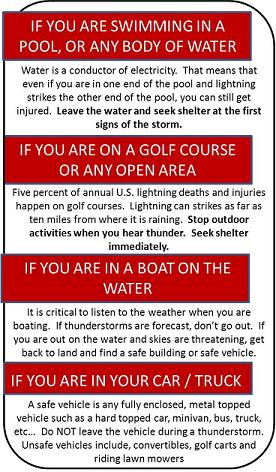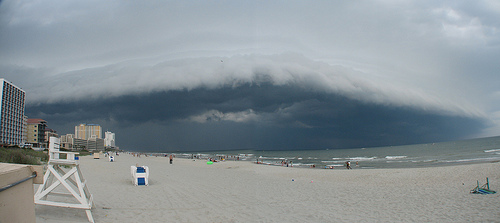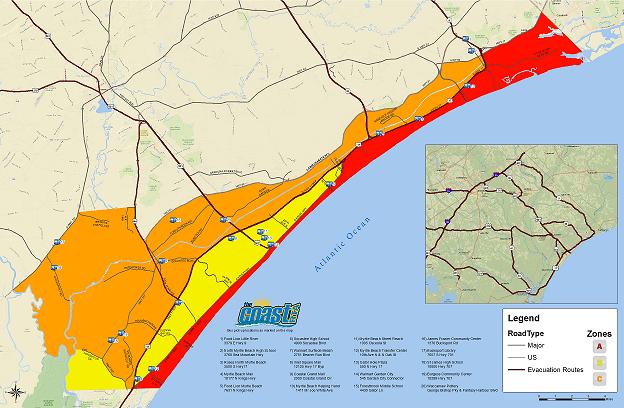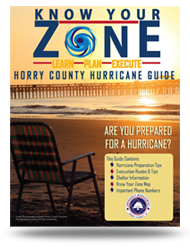With the devastation from Hurricane Sandy last season and the recent tornadoes leveling parts of Oklahoma, the threat of severe weather is becoming more real for many Americans. Whether you are facing a thunderstorm, hail, a hurricane, rip currents or a lightning strike, it is important that you are well informed and prepared to keep you, your family, your pets and your belongings safe and secure. We, here at Cumulus Media – Myrtle Beach are committed to providing you that information you need, when you need it.
This Severe Weather Guide is brought to you by these proud sponsors:
Severe Thunderstorms
The forecast this time of year often calls for partly sunny skies and scattered afternoon thunderstorms. Warm air rising from the hot ground can cause the atmosphere to become unstable and thunderstorms to form. A passing cold front or approaching storm system can also trigger thunderstorms. At any given moment, there are roughly 2,000 thunderstorms in progress around the world. An average thunderstorm is 15 miles in diameter and lasts around 30 minutes. Sometimes these are quick downpours. However, a small percentage of thunderstorms are severe, meaning they contain hail threee-fourths of an inch in diameter, frequent lightning strikes and winds 58 mph or stronger.
If conditions are favorable for severe thunderstorms to form, the National Weather Service will issue a severe thunderstorm watch. If this type of dangerous storm is spotted on radarand is imminent, then a severe thunderstorm warning is issued. A warning is more serious than a watch. However, whenever you hear the roar of thunder, seek shelter immediately. Do not wait until you see a flash of lightning.
Wide open space can be dangerous places because shelter can be far away. According to the National Lightning Safety Institute, about 5 percent of lightning deaths in the U.S. annually occur on golf courses.

Hurricanes
In the summer and early fall months tropical disturbances form, and if the weather conditions are ripe for their development – these swirls of thunderstorms can grow into monster hurricanes. The heat of the warm ocean waters fuels the storms, allowing an area of disturbed weather to grow into a tropical depression, with winds of 38 mph or less, and then to tropical storm status, with winds 39 to 74 mph. That’s when the storm officially gets its name. When a tropical storm’s maximum winds grow to 74 mph or greater, it becomes a hurricane.
Hurricane winds may start at 74 mph, but they can intensify to catastrophic levels. The strongest being a Category 5 with winds exceeding 155 mph. In 2005 hurricanes Katrina, Rita and Wilma all reached Category 5 status. Keep in mind that even a weak tropical storm can be very dangerous and preparations for your home should be made well in advance of the storm approaching.
Though you might think the monumental force of 100-plus mph winds would be the most dealy effect of hurricanes, flooding is the leading killer in hurricanes. That is particularly true on the coast where the storm surge, and abnormal rise in water generated by a storm, can occur.
Even if you don’t live or vacation directly in a coastal area, the impact of hurricanes can still affect you. Strong hurricanes can cause flooding well inland from where the storm makes landfall. They can also spawn tornadoes and severe thunderstorms far from the coast.
2013 Atlantic Hurricane Names
Andrea, Barry, Chantal, Dorian, Erin, Fernand, Gabrielle, Humberto, Ingrid, Jerry, Karen, Lorenzo, Melissa, Nestor, Olga, Pablo, Rebekah, Sebastien, Tanya, Van and Wendy
Know Your Zone
Know Your Zone is a public education campaign to inform the citizens and visitors of Horry County of the new hurricane evacuation zones and their vulnerability to storm surge. The Know Your Zone campaign was developed as a result of the information contained in the South Carolina Hurricane Evacuation Study (HES) for the Northern Conglomerate that was released by the Federal Emergency Management Agency (FEMA) and the US Army Corps of Engineers (USACE) in 2012. The campaign also reflects the National Hurricane Center’s (NHC) decision to separate the association of storm surge inundation from the category of storm.
Zone A – All areas east of U.S. Business 17 (Kings Hwy), up to intersection with U.S. 17 (Kings Hwy) and then all areas east of US 17 (Kings Hwy) to the Northern county line.
Zone B – All areas south of Hwy 707 and Longwood Drive, including all areas in Longwood Plantation (Blackmoor) to the Waccamaw River and all areas east of U.S. 17 Bypass (Mark Garner Hwy) to U.S. 17 (North Kings Hwy) and all areas east of U.S. 17 (North Kings Hwy) to the northern county line.
Zone C – All areas between Hwy 701 and Hwy 544, south of Brown’s Chapel Avenue and Hwy 814, plus all areas east of Highway 31 (Carolina Bays Parkway) to Highway 90 and all areas east of Highway 90 to U.S. 17 to the northern county line.
*This also includes all flood prone areas along the Waccamaw River and the Great and Little Pee Dee Rivers, as well as all mobile home residents within Horry County.
Click below to print your own
Horry County Hurricane Guide.
Tracking Charts
http://www.nhc.noaa.gov/tracking_charts.shtml
According to the folks at FEMA, below are safety mesaures that you should take to keep you and your family safe before, during and after a hurricane.
Before a Hurricane
To prepare for a hurricane, you should take the following measures:
- To begin preparing, you should build an emergency kit and make a family communications plan.
- Know your surroundings.
- Learn the elevation level of your property and whether the land is flood-prone. This will help you know how your property will be affected when storm surge or tidal flooding are forecasted.
- Identify levees and dams in your area and determine whether they pose a hazard to you.
- Learn community hurricane evacuation routes and how to find higher ground. Determine where you would go and how you would get there if you needed to evacuate.
- Make plans to secure your property:
- Cover all of your home’s windows. Permanent storm shutters offer the best protection for windows. A second option is to board up windows with 5/8” marine plywood, cut to fit and ready to install. Tape does not prevent windows from breaking.
- Install straps or additional clips to securely fasten your roof to the frame structure. This will reduce roof damage.
- Be sure trees and shrubs around your home are well trimmed so they are more wind resistant.
- Clear loose and clogged rain gutters and downspouts.
- Reinforce your garage doors; if wind enters a garage it can cause dangerous and expensive structural damage.
- Plan to bring in all outdoor furniture, decorations, garbage cans and anything else that is not tied down.
- Determine how and where to secure your boat.
- Install a generator for emergencies.
- If in a high-rise building, be prepared to take shelter on or below the 10th floor.
- Consider building a safe room.
Hurricanes cause heavy rains that can cause extensive flood damage in coastal and inland areas. Everyone is at risk and should consider flood insurance protection. Flood insurance is the only way to financially protect your property or business from flood damage. To learn more about your flooding risk and how to protect yourself and your business, visit the Federal Insurance and Mitigation Administration (NFIP) Web site,www.floodsmart.gov or call 1-800-427-2419.
During a Hurricane
If a hurricane is likely in your area, you should:
- Listen to the radio or TV for information.
- Secure your home, close storm shutters and secure outdoor objects or bring them indoors.
- Turn off utilities if instructed to do so. Otherwise, turn the refrigerator thermostat to its coldest setting and keep its doors closed.
- Turn off propane tanks
- Avoid using the phone, except for serious emergencies.
- Moor your boat if time permits.
- Ensure a supply of water for sanitary purpose such as cleaning and flushing toilets. Fill the bathtub and other larger containers with water.
- Find out how to keep food safe during and after and emergency.
You should evacuate under the following conditions:
If you are directed by local authorities to do so. Be sure to follow their instructions.
- If you live in a mobile home or temporary structure – such shelter are particularly hazardous during hurricane no matter how well fastened to the ground.
- If you live in a high-rise building – hurricane winds are stronger at higher elevations.
- If you live on the coast, on a floodplain, near a river, or on an island waterway.
Read more about evacuating yourself and your family. If you are unable to evacuate, go to your wind-safe room. If you do not have one, follow these guidelines:
- Stay indoors during the hurricane and away from windows and glass doors.
- Close all interior doors – secure and brace external doors.
- Keep curtains and blinds closed. Do not be fooled if there is a lull; it could be the eye of the storm – winds will pick up again.
- Take refuge in a small interior room, closet or hallway on the lowest level.
- Lie on the floor under a table or another sturdy object.
- Avoid elevators.
After a Hurricane
- Continue listening to a NOAA Weather Radio or the local news for the latest updates.
- Stay alert for extended rainfall and subsequent flooding even after the hurricane or tropical storm has ended.
- If you have become separated from your family, use your family communications plan or contact the American Red Cross at 1-800-RED-CROSS/1-800-733-2767 or visit the American Red Cross Safe and Well site:www.safeandwell.org
- The American Red Cross also maintains a database to help you find family. Contact the local American Red Cross chapter where you are staying for information. Do not contact the chapter in the disaster area.
- If you evacuated, return home only when officials say it is safe.
- If you cannot return home and have immediate housing needs. Text SHELTER + your ZIP code to 43362 (4FEMA) to find the nearest shelter in your area (example: shelter 12345).
- For those who have longer-term housing needs, FEMA offers several types of assistance, including services and grants to help people repair their homes and find replacement housing. Apply for assistance or search for information about housing rental resources
- Drive only if necessary and avoid flooded roads and washed¬ out bridges. Stay off the streets. If you must go out watch for fallen objects; downed electrical wires; and weakened walls, bridges, roads, and sidewalks.
- Keep away from loose or dangling power lines and report them immediately to the power company.
- Walk carefully around the outside your home and check for loose power lines, gas leaks and structural damage before entering.
- Stay out of any building if you smell gas, floodwaters remain around the building or your home was damaged by fire and the authorities have not declared it safe.
- Inspect your home for damage. Take pictures of damage, both of the building and its contents, for insurance purposes. If you have any doubts about safety, have your residence inspected by a qualified building inspector or structural engineer before entering.
- Use battery-powered flashlights in the dark. Do NOT use candles. Note: The flashlight should be turned on outside before entering – the battery may produce a spark that could ignite leaking gas, if present.
- Watch your pets closely and keep them under your direct control. Watch out for wild animals, especially poisonous snakes. Use a stick to poke through debris.
- Avoid drinking or preparing food with tap water until you are sure it’s not contaminated.
- Check refrigerated food for spoilage. If in doubt, throw it out.
- Wear protective clothing and be cautious when cleaning up to avoid injury.
- Use the telephone only for emergency calls.
- NEVER use a generator inside homes, garages, crawlspaces, sheds, or similar areas, even when using fans or opening doors and windows for ventilation. Deadly levels of carbon monoxide can quickly build up in these areas and can linger for hours, even after the generator has shut off.
Tornadoes
Rip Currents
Hail
Disaster Plan
Heat Effects
Local Emergency Contacts
Shelter Listings
Driving Tips
Pet Safety
Summer Pests
Outdoor Exercise Tips
Sun Protection
Pool Safety
Mold
Evacuation Routes
Pre-Storm Checklist
Straight-Line Winds









